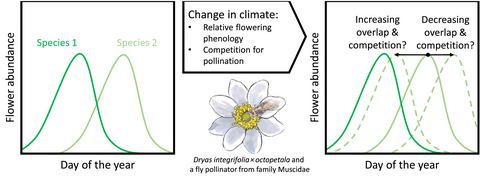当前位置:
X-MOL 学术
›
Glob. Change Biol.
›
论文详情
Our official English website, www.x-mol.net, welcomes your
feedback! (Note: you will need to create a separate account there.)
Heated rivalries: Phenological variation modifies competition for pollinators among arctic plants.
Global Change Biology ( IF 10.8 ) Pub Date : 2020-09-11 , DOI: 10.1111/gcb.15303 Mikko Tiusanen 1 , Tuomas Kankaanpää 1 , Niels M Schmidt 2, 3 , Tomas Roslin 1, 4
Global Change Biology ( IF 10.8 ) Pub Date : 2020-09-11 , DOI: 10.1111/gcb.15303 Mikko Tiusanen 1 , Tuomas Kankaanpää 1 , Niels M Schmidt 2, 3 , Tomas Roslin 1, 4
Affiliation

|
When plant species compete for pollinators, climate warming may cause directional change in flowering overlap, thereby shifting the strength of pollinator‐mediated plant–plant interactions. Such shifts are likely accentuated in the rapidly warming Arctic. Targeting a plant community in Northeast Greenland, we asked (a) whether the relative phenology of plants is shifting with spatial variation in temperature, (b) whether local plants compete for pollination, and (c) whether shifts in climatic conditions are likely to affect this competition. We first searched for climatic imprints on relative species phenology along an elevational gradient. We then tested for signs of competition with increasing flower densities: reduced pollinator visits, reduced representation of plant species in pollen loads, and reduced seed production. Finally, we evaluated how climate change may affect this competition. Compared to a dominant species, Dryas integrifolia × octopetala, the relative timing of other species shifted along the environmental gradient, with Silene acaulis and Papaver radicatum flowering earlier toward higher elevation. This shift resulted in larger niche overlap, allowing for an increased potential for competition for pollination. Meanwhile, Dryas emerged as a superior competitor by attracting 97.2% of flower visits. Higher Dryas density resulted in reduced insect visits and less pollen of S. acaulis being carried by pollinators, causing reduced seed set by S. acaulis. Our results show that current variation in climate shifts the timing and flowering overlap between dominant and less‐competitive plant species. With climate warming, such shifts in phenology within trophic levels may ultimately affect interactions between them, changing the strength of competition among plants.
中文翻译:

激烈的竞争:物候变化改变了北极植物之间对传粉者的竞争。
当植物物种争夺传粉者时,气候变暖可能会导致开花重叠的方向性变化,从而改变传粉者介导的植物与植物相互作用的强度。在迅速变暖的北极,这种变化可能会加剧。针对格陵兰岛东北部的一个植物群落,我们询问(a)植物的相对物候是否随着温度的空间变化而变化,(b)当地植物是否竞争授粉,以及(c)气候条件的变化是否可能影响本次比赛。我们首先沿着海拔梯度寻找相对物种物候学的气候印记。然后,我们测试了随着花朵密度增加而产生的竞争迹象:传粉者访问减少、花粉负载中植物物种的代表性减少以及种子产量减少。最后,我们评估了气候变化可能如何影响这场比赛。与优势种Dryas integrifolia × octopetala相比,其他物种的相对时间随环境梯度发生变化,其中Silene acaulis和Papaver radicatum向高海拔地区开花较早。这种转变导致了更大的生态位重叠,从而增加了授粉竞争的潜力。与此同时,仙女木吸引了 97.2% 的花卉参观者,成为了一个强大的竞争对手。较高的仙女木密度导致昆虫访问量减少,传粉者携带的S. acaulis花粉减少,导致S. acaulis结籽减少。我们的结果表明,当前的气候变化改变了优势植物物种和竞争较弱植物物种之间的时间和开花重叠。 随着气候变暖,营养级内物候的这种变化可能最终会影响它们之间的相互作用,从而改变植物之间的竞争强度。
更新日期:2020-10-19
中文翻译:

激烈的竞争:物候变化改变了北极植物之间对传粉者的竞争。
当植物物种争夺传粉者时,气候变暖可能会导致开花重叠的方向性变化,从而改变传粉者介导的植物与植物相互作用的强度。在迅速变暖的北极,这种变化可能会加剧。针对格陵兰岛东北部的一个植物群落,我们询问(a)植物的相对物候是否随着温度的空间变化而变化,(b)当地植物是否竞争授粉,以及(c)气候条件的变化是否可能影响本次比赛。我们首先沿着海拔梯度寻找相对物种物候学的气候印记。然后,我们测试了随着花朵密度增加而产生的竞争迹象:传粉者访问减少、花粉负载中植物物种的代表性减少以及种子产量减少。最后,我们评估了气候变化可能如何影响这场比赛。与优势种Dryas integrifolia × octopetala相比,其他物种的相对时间随环境梯度发生变化,其中Silene acaulis和Papaver radicatum向高海拔地区开花较早。这种转变导致了更大的生态位重叠,从而增加了授粉竞争的潜力。与此同时,仙女木吸引了 97.2% 的花卉参观者,成为了一个强大的竞争对手。较高的仙女木密度导致昆虫访问量减少,传粉者携带的S. acaulis花粉减少,导致S. acaulis结籽减少。我们的结果表明,当前的气候变化改变了优势植物物种和竞争较弱植物物种之间的时间和开花重叠。 随着气候变暖,营养级内物候的这种变化可能最终会影响它们之间的相互作用,从而改变植物之间的竞争强度。











































 京公网安备 11010802027423号
京公网安备 11010802027423号